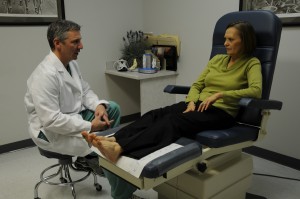Early action and nutritional therapies bring hope for diabetes patients with foot problems
The eyes may be the window to the soul, but when it comes to health, the feet are often the first place where signs of a problem appear – especially in people living with type 2 diabetes. A person with diabetes is most likely to experience symptoms in their feet earlier than any other part of the body, yet those symptoms often go unnoticed or misinterpreted.
 Foot problems in people with diabetes may herald diabetic peripheral neuropathy (DPN) – a serious complication of diabetes. The good news is that with a proactive approach to foot health, and the right therapies, it is possible for diabetes patients to stem the progress of their DPN.
Foot problems in people with diabetes may herald diabetic peripheral neuropathy (DPN) – a serious complication of diabetes. The good news is that with a proactive approach to foot health, and the right therapies, it is possible for diabetes patients to stem the progress of their DPN.
While pain is the most common symptom of DPN – and the one that gets the most attention – a lack of pain, or more specifically, lack of any sensation, can be even more damaging.
“The sensory loss often associated with DPN can lead to a loss of protective sensation, and can cause infections which can lead to amputations,” says Dr. Todd Levine, director of Corinthian Labs in Phoenix, and an international authority on DPN and type 2 diabetes. “We believe there are ways to slow down or reverse the progress of DPN, so the earlier you recognize the problem the easier it is to reverse the condition.”
DPN is one of two factors that make people with diabetes more likely to have a foot or leg amputated than other people, according to the American Diabetes Association (ADA). The risk is so much greater that the American Podiatric Medical Association says more than 60 percent of non-traumatic lower-limb amputations in the United States are performed on people with diabetes. However, the ADA says, most amputations could be prevented with regular care and proper footwear.
Levine concurs. “Typically, the prognosis for DPN patients has been that they have gotten worse or, at best, stayed the same,” he says. “There has always been the concern for amputation and infection. But there are ways to slow down or reverse this disease.”
“Many studies are being conducted right now to find ways to reverse DPN,” Levine says. “Some of this is with specific nerve growth factors. Some is by diet and exercise, and some through nutritional supplementation.”
Successful therapies usually include diet and exercise, controlling blood sugar, and treating DPN with products like Metanx, Levine says. Available only by prescription, the medical food provides the nutritional requirements diabetes patients need to restore the metabolic processes associated with diabetic neuropathy.
Levine offers some additional advice for patients with type 2 diabetes:
* Be alert to changes in your feet. You may experience pain, a loss of sensation or even balance problems; these can be signs that DPN may be developing.
* See a medical professional at the first sign of a problem, including foot pain or numbness. Visit your primary care doctor, a podiatrist or a neurologist.
* Talk to your doctor about DPN, and ask if he or she is concerned about it. If so, ask if you would benefit from testing to prove the condition is present, or if your foot pain may have other causes.
* Discuss therapies that not only treat your discomfort, but also slow the progression of neuropathy.
It’s important for patients to seek out doctors with experience treating DPN, Levine says. Communication and early intervention are key, he adds. “The earlier people take an active role in their disease, the better they will be in the long run.”
To learn more about DPN, visit www.diabetes.org, www.neuropathy.org or www.diabeticconnect.com.


















